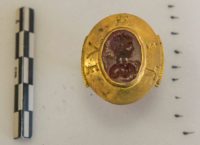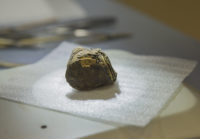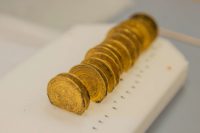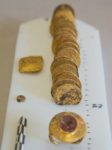 A hoard of hidden medieval treasure, a fortune in gold and silver coins, was an unexpectedly discovered during an excavation at the site of the famed medieval Abbey of Cluny in Saône-et-Loire, eastern France. The team, which includes nine students doing field work as part of the University Lumière Lyon 2’s archaeology masters program, unearthed the hoard in mid-September while looking for the remains of an infirmary believed to have been located there in the Middle Ages.
A hoard of hidden medieval treasure, a fortune in gold and silver coins, was an unexpectedly discovered during an excavation at the site of the famed medieval Abbey of Cluny in Saône-et-Loire, eastern France. The team, which includes nine students doing field work as part of the University Lumière Lyon 2’s archaeology masters program, unearthed the hoard in mid-September while looking for the remains of an infirmary believed to have been located there in the Middle Ages.
The medieval loot included 2,200 deniers (or pieces of silver) mostly issued by Cluny Abbey itself as well as 21 gold dinar coins, originally from the Middle East which were stored in a canvas bag.
The bounty also included a gold signet ring marked with the word “Avete” — a “word of greeting in a religious context” — as well as a folded 24-gram gold leaf and gold coin.
“The overall value of this treasure for the time is estimated between three and eight horses, the equivalent of cars nowadays, but in terms of the running of the abbey it’s not that much, amounting to about six days of supply of bread and wine,” said specialist Vincent Borrel.
 In terms of archaeological and historical value, this treasure is off the charts. It is the first 12th century Cluniac treasure discovered in its original context during an archaeological excavation. It’s also the largest number of silver deniers discovered in one place and the only single hoard ever found to include Arabic coins, silver deniers and a signet ring. The intaglio stone is ancient Roman and engraved with the profile of a deity. (Religious context or no religious context, ancient engravings were prestige items and often used as signet rings by the medieval elite.)
In terms of archaeological and historical value, this treasure is off the charts. It is the first 12th century Cluniac treasure discovered in its original context during an archaeological excavation. It’s also the largest number of silver deniers discovered in one place and the only single hoard ever found to include Arabic coins, silver deniers and a signet ring. The intaglio stone is ancient Roman and engraved with the profile of a deity. (Religious context or no religious context, ancient engravings were prestige items and often used as signet rings by the medieval elite.)
 Also of note is the survival of fragments of the original bag the hoard was stashed in. Fragments of it are still attached to some of the coins. There is also a surviving piece of tanned animal hide which was tied around the bundle of 21 gold dinars minted between 1121 and 1131 in Spain and Morocco during the reign of Almoravid sultan Ali Ben Youssef (1106-1143).
Also of note is the survival of fragments of the original bag the hoard was stashed in. Fragments of it are still attached to some of the coins. There is also a surviving piece of tanned animal hide which was tied around the bundle of 21 gold dinars minted between 1121 and 1131 in Spain and Morocco during the reign of Almoravid sultan Ali Ben Youssef (1106-1143).
 Practically from the time of its founding by by Duke William I of Aquitaine in 910 A.D., the Benedictine monastery of Cluny was one of the great monastic centers of Western Europe. They followed a strict interpretation of the Rule of Saint Benedict that within decades had catapulted Cluny to the top of the ranks, making the abbey the undoubted leader in European monasticism. The city of Cluny grew into a city thanks largely to the Abbey and the trade, employment and pilgrim moneys it brought to town. By the second half of the 10th century, the Abbey of Cluny was already well-established as the top monastery in the country and it retained its prominence into the 12th century.
Practically from the time of its founding by by Duke William I of Aquitaine in 910 A.D., the Benedictine monastery of Cluny was one of the great monastic centers of Western Europe. They followed a strict interpretation of the Rule of Saint Benedict that within decades had catapulted Cluny to the top of the ranks, making the abbey the undoubted leader in European monasticism. The city of Cluny grew into a city thanks largely to the Abbey and the trade, employment and pilgrim moneys it brought to town. By the second half of the 10th century, the Abbey of Cluny was already well-established as the top monastery in the country and it retained its prominence into the 12th century.
 Its influence began to wane when newer, more austere orders stole Benedictine thunder and the idea of remote rule by a single abbot, distant from the satellite houses and largely unaccountable, lost its appeal. In the 16th century the Abbey of Cluny was sacked by Hugenots and never really recovered. Come the French Revolution, the monastic order was dissolved and under Napoleon the abbey itself was demolished and used as a quarry. Today only one of its eight grand towers still stands, which is why archaeologists continue to excavate it today, 90 years after the first archaeological explorations of the site began.
Its influence began to wane when newer, more austere orders stole Benedictine thunder and the idea of remote rule by a single abbot, distant from the satellite houses and largely unaccountable, lost its appeal. In the 16th century the Abbey of Cluny was sacked by Hugenots and never really recovered. Come the French Revolution, the monastic order was dissolved and under Napoleon the abbey itself was demolished and used as a quarry. Today only one of its eight grand towers still stands, which is why archaeologists continue to excavate it today, 90 years after the first archaeological explorations of the site began.